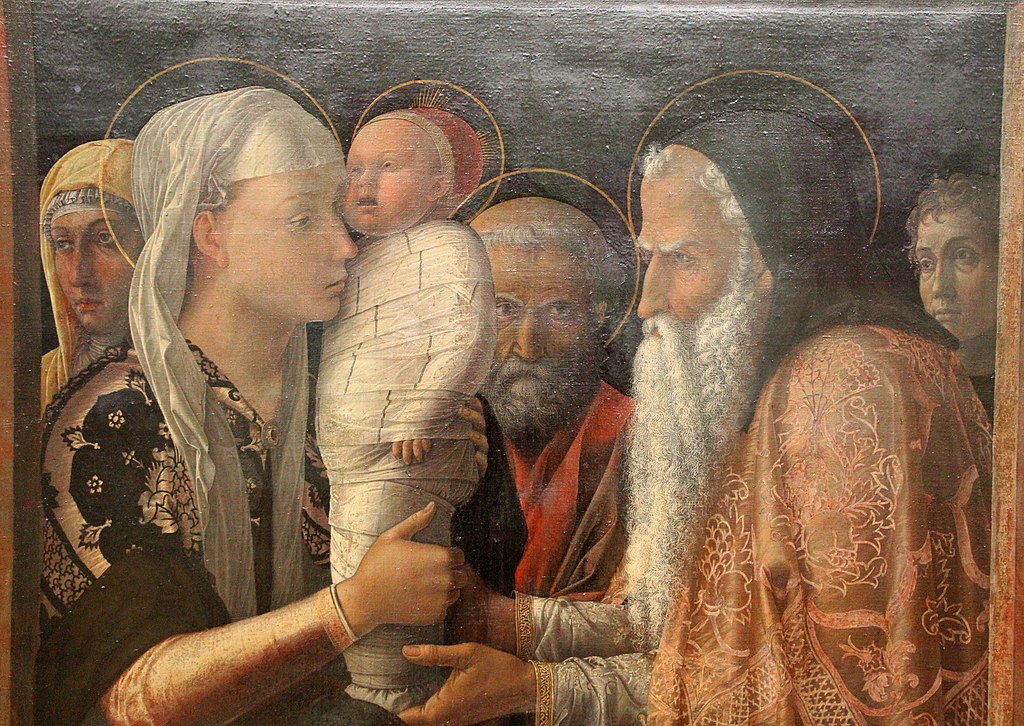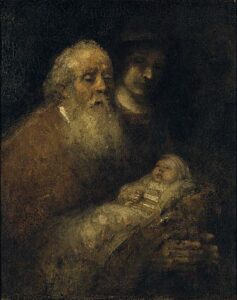By Canon Ian Morter
This Sunday the Church celebrates the feast of The Presentation of Christ in the Temple, sometimes called Candlemas. It marks one of the pivotal moments in the Christian year. This is because, on this day, we officially finish the season of Christmas, the time when we focus of God coming amongst us, – the Incarnation, in the person of his Son, Jesus Christ. Now we set our thoughts on Jesus’ passion, death and resurrection; Christ fulfilling his destiny as the Son of God, as our Saviour.
 I have chosen a painting illustrating The Presentation of Christ, so let me explain what it is depicting:
I have chosen a painting illustrating The Presentation of Christ, so let me explain what it is depicting:
It is the event described by St Luke in his Gospel Chapter 2:2 2-40. At just 40 days old every first born male has to be presented to God in the Temple at Jerusalem. It was an act of consecration of the life of the child to God, as prescribed in the Exodus 13: 1- 2 & 12-13. But the child would be “redeemed” by the parents in the offering of two doves or, if they were poor, two young pigeons. Mary and Joseph, in fulfilling the requirements of the Law of Moses, dutifully went with their young infant and presented him to God. In the Temple they were meet by the elderly Simeon, who had been promised that before he died he would see the Lord’s Anointed – The Messiah. He greeted the parents, having recognised in the infant Jesus that God’s promise had been fulfilled. He gave praise to God with the words “Lord now let your servant depart in peace, according to your word”. The Song of Simeon, as it is often referred to, is an integral part of the Church’s evening service and is sung or said every day in Exeter Cathedral. Mary and Joseph were amazed at what was being said about their son, but Simeon went further. He prophesised that Jesus would be destined to be both a blessing to Israel but also would face opposition and be a “sword that would pierce the heart” of Mary.
What is not depicted in this painting, is the family’s meeting with the elderly prophetess Anna, “who never left the Temple, but worshipped there with fasting night and day”. Encountering the family she “praised God and witnessed to those who were looking for the redemption of Jerusalem”.
Let us now turn to this picture for a few moments. It was painted in about 1455 by an Italian Renaissance artist born in Padua – Andre Mantegna, in the early years of his career, using egg tempera on canvas. It is quite small being only 69cm x 86cm and is now displayed in the Gemaldegalerie in Berlin.
Unusually, the painting is set in a marble frame with a cushion, on which the Child is supported, protruding into the viewer’s space. Mary on the left foreground, holding the Child, while the bearded Simeon is on her right, with Joseph set between. In the background, on either side, are two spectators (without halos). They may possibly be Mantegna’s self-portrait and a portrait of his wife, Nicolosia.
 This second painting, titled Simeon’s Song of Praise is by Dutch artist Rembrandt Van Rijn and painted in oil on canvas. It is unfinished, as it was started in the last year of his life – 1669. So this was probably the last of over 300 paintings that he created in his long and distinguished career. I have seen this painting in the Nationmusaum of Stockholm when I visited the city in 2023. Rembrandt, having a long career, developed his style over the years, and to me this painting is reminiscent of The Return of the Prodigal Son that is in the Hermitage Museum in Saint Petersburg, and was painted about two years before the artist’s death. They both have a much looser style than his earlier works.
This second painting, titled Simeon’s Song of Praise is by Dutch artist Rembrandt Van Rijn and painted in oil on canvas. It is unfinished, as it was started in the last year of his life – 1669. So this was probably the last of over 300 paintings that he created in his long and distinguished career. I have seen this painting in the Nationmusaum of Stockholm when I visited the city in 2023. Rembrandt, having a long career, developed his style over the years, and to me this painting is reminiscent of The Return of the Prodigal Son that is in the Hermitage Museum in Saint Petersburg, and was painted about two years before the artist’s death. They both have a much looser style than his earlier works.
In brief, this scene is a much more concise depiction of the story of The Presentation. We see Simeon lovingly holding the infant Jesus, a much more realistic forty-day-old child – not swaddled, but in a shawl. The woman in the background may either represent the Virgin Mary or the prophetess, Anna. Stylistically, we can detect that this person was probably added after artist’s death by an unknown painter working in Rembrandt’s workshop. The scene has a sense of being much more mystical, caught in the shadows of the Temple portico. I feel the genuine sense of awe, wonder and love of the priest who has now fulfilled his life and ministry by seeing the Lord’s Anointed. “Lord now let your servant depart in peace”.
Image 1: Andrea Mantegna: Presentation at the Temple, Source: Wikimedia Commons
Image 2: Rembrandt: Simeon’s Song of Praise, Source: Wikimedia Commons